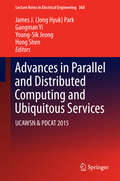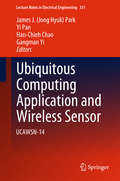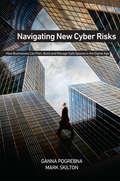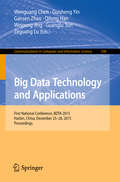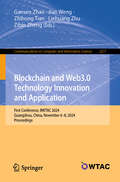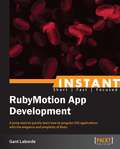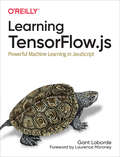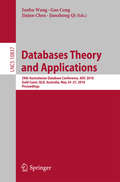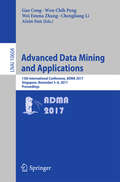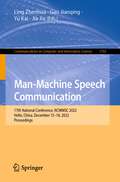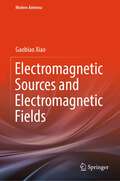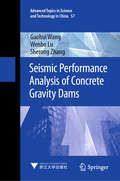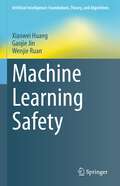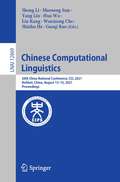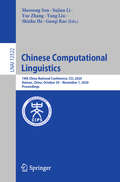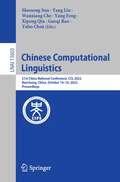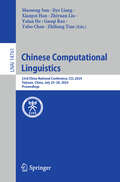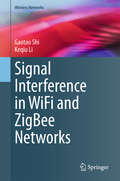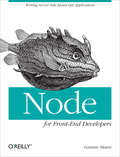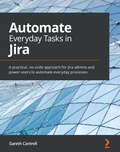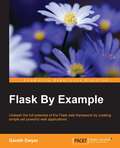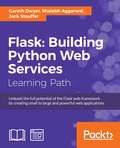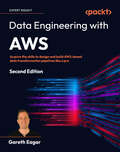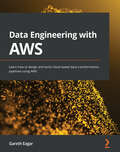- Table View
- List View
Advances in Parallel and Distributed Computing and Ubiquitous Services: UCAWSN & PDCAT 2015 (Lecture Notes in Electrical Engineering #368)
by Hong Shen James J. Jong Hyuk Park Gangman Yi Young-Sik JeongThis book contains the combined proceedings of the 4th International Conference on Ubiquitous Computing Application and Wireless Sensor Network (UCAWSN-15) and the 16th International Conference on Parallel and Distributed Computing, Applications and Technologies (PDCAT-15). The combined proceedings present peer-reviewed contributions from academic and industrial researchers in fields including ubiquitous and context-aware computing, context-awareness reasoning and representation, location awareness services, and architectures, protocols and algorithms, energy, management and control of wireless sensor networks. The book includes the latest research results, practical developments and applications in parallel/distributed architectures, wireless networks and mobile computing, formal methods and programming languages, network routing and communication algorithms, database applications and data mining, access control and authorization and privacy preserving computation.
Ubiquitous Computing Application and Wireless Sensor
by Yi Pan James J. Jong Hyuk Park Gangman Yi Han-Chieh ChaoIT changes everyday's life, especially in education and medicine. The goal of ITME 2014 is to further explore the theoretical and practical issues of Ubiquitous Computing Application and Wireless Sensor Network. It also aims to foster new ideas and collaboration between researchers and practitioners. The organizing committee is soliciting unpublished papers for the main conference and its special tracks.
Navigating New Cyber Risks: How Businesses Can Plan, Build and Manage Safe Spaces in the Digital Age
by Mark Skilton Ganna PogrebnaThis book is a means to diagnose, anticipate and address new cyber risks and vulnerabilities while building a secure digital environment inside and around businesses. It empowers decision makers to apply a human-centred vision and a behavioral approach to cyber security problems in order to detect risks and effectively communicate them. The authors bring together leading experts in the field to build a step-by-step toolkit on how to embed human values into the design of safe human-cyber spaces in the new digital economy. They artfully translate cutting-edge behavioral science and artificial intelligence research into practical insights for business. As well as providing executives, risk assessment analysts and practitioners with practical guidance on navigating cyber risks within their organizations, this book will help policy makers better understand the complexity of business decision-making in the digital age. Step by step, Pogrebna and Skilton show you how to anticipate and diagnose new threats to your business from advanced and AI-driven cyber-attacks.
Big Data Technology and Applications: First National Conference, BDTA 2015, Harbin, China, December 25-26, 2015. Proceedings (Communications in Computer and Information Science #590)
by Qilong Han Weipeng Jing Guanglu Sun Zeguang Lu Wenguang Chen Guisheng Yin Gansen ZhaoThis bookconstitutes the refereed proceedings of the First National Conference on BigData Technology and Applications, BDTA 2015, held in Harbin, China, in December2015. The 26revised papers presented were carefully reviewed and selected from numeroussubmissions. The papers address issues such as the storage technology of Big Data;analysis of Big Data and data mining; visualization of Big Data; the parallelcomputing framework under Big Data; the architecture and basic theory of BigData; collection and preprocessing of Big Data; innovative applications in someareas, such as internet of things and cloud computing.
Blockchain and Web3.0 Technology Innovation and Application: First Conference, BWTAC 2024, Guangzhou, China, November 6–8, 2024, Proceedings (Communications in Computer and Information Science #2277)
by Zibin Zheng Gansen Zhao Liehuang Zhu Jian Weng Zhihong TianThis book constitutes the refereed proceedings of the First Conference on Blockchain and Web3 Technology Innovation and Application, BWTAC 2024, held in Guangzhou, China, during, November 6–8, 2024. The 36 full papers and 9 short papers included in this book were carefully reviewed and selected from 106 submissions. They were categorized in the following topica sections: Architectures and Technologies, Privacy Protection and Data Security, Artificial Intelligences, Security, Trading Systems, Cross Domains Applications and Emerging Technologies.
Instant RubyMotion App Development
by Gant LabordeGet to grips with a new technology, understand what it is and what it can do for you, and then get to work with the most important features and tasks. This book is a practical, task-based, step-by-step tutorial that will get you started with using RubyMotion to quickly and efficiently write iOS apps.To make the most of this book, you should understand the basics of programming concepts and have a basic understanding of a language similar to Ruby. If you are an Objective-C programmer, you'll learn the advantages of RubyMotion which can access the benefits of Cocoapods, but takes everything a step further with RubyGems. If you're a Ruby programmer you'll learn the inner workings of the Cocoa framework and find out how to effectively bring your skill set into mobile development.
Learning TensorFlow.js: Powerful Machine Learning In Javascript
by Gant LabordeGiven the demand for AI and the ubiquity of JavaScript, TensorFlow.js was inevitable. With this Google framework, seasoned AI veterans and web developers alike can help propel the future of AI-driven websites. In this guide, author Gant Laborde (Google Developer Expert in machine learning and the web) provides a hands-on end-to-end approach to TensorFlow.js fundamentals for a broad technical audience that includes data scientists, engineers, web developers, students, and researchers.You'll begin by working through some basic examples in TensorFlow.js before diving deeper into neural network architectures, DataFrames, TensorFlow Hub, model conversion, transfer learning, and more. Once you finish this book, you'll know how to build and deploy production-readydeep learning systems with TensorFlow.js.Explore tensors, the most fundamental structure of machine learningConvert data into tensors and back with a real-world exampleCombine AI with the web using TensorFlow.jsUse resources to convert, train, and manage machine learning dataBuild and train your own training models from scratch
Databases Theory and Applications: 26th Australasian Database Conference, Adc 2015, Melbourne, Vic, Australia, June 4-7, 2015. Proceedings (Theoretical Computer Science and General Issues #9093)
by Jinjun Chen Gao Cong Junhu Wang Jianzhong QiThis book constitutes the refereed proceedings of the 29th Australasian Database Conference, ADC 2018, held in Gold Coast, QLD, Australia, in May 2018.The 23 full papers plus 6 short papers presented together with 3 demo papers were carefully reviewed and selected from 53 submissions. The Australasian Database Conference is an annual international forum for sharing the latest research advancements and novel applications of database systems, data-driven applications, and data analytics between researchers and practitioners from around the globe, particularly Australia and New Zealand.
Advanced Data Mining and Applications: 13th International Conference, ADMA 2017, Singapore, November 5–6, 2017, Proceedings (Lecture Notes in Computer Science #10604)
by Gao Cong, Wen-Chih Peng, Wei Emma Zhang, Chengliang Li and Aixin SunThis book constitutes the refereed proceedings of the 13th International Conference on Advanced Data Mining and Applications, ADMA 2017, held in Singapore in November 2017. The 20 full and 38 short papers presented in this volume were carefully reviewed and selected from 118 submissions. The papers were organized in topical sections named: database and distributed machine learning; recommender system; social network and social media; machine learning; classification and clustering methods; behavior modeling and user profiling; bioinformatics and medical data analysis; spatio-temporal data; natural language processing and text mining; data mining applications; applications; and demos.
Man-Machine Speech Communication: 17th National Conference, NCMMSC 2022, Hefei, China, December 15–18, 2022, Proceedings (Communications in Computer and Information Science #1765)
by Ling Zhenhua Gao Jianqing Yu Kai Jia JiaThis book constitutes the refereed proceedings of the 17th National Conference on Man–Machine Speech Communication, NCMMSC 2022, held in China, in December 2022.The 21 full papers and 7 short papers included in this book were carefully reviewed and selected from 108 submissions. They were organized in topical sections as follows: MCPN: A Multiple Cross-Perception Network for Real-Time Emotion Recognition in Conversation.- Baby Cry Recognition Based on Acoustic Segment Model, MnTTS2 An Open-Source Multi-Speaker Mongolian Text-to-Speech Synthesis Dataset.
Electromagnetic Sources and Electromagnetic Fields (Modern Antenna)
by Gaobiao XiaoThis book presents a modified spherical harmonic expansion method in which the electromagnetic fields and their sources are expanded with the same set of spherical vector basis functions in a similar procedure. Explicit expressions for the electromagnetic fields, potentials, energies, and the related Green’s functions are derived for the spherical modes in both frequency domain and time domain. Based on the formulation, the relationships between the electromagnetic sources, the electromagnetic far fields, and the electromagnetic near fields are clearly revealed. In particular, a nonuniform transmission line model is developed for intuitively characterizing the total radiation process. The introduction of the cutoff radius and the cutoff mode degree provides a simple reference for determining the numbers of degrees of freedom of the fields associated with sources in a bounded region. Based on the theory, an efficient hybrid method for synthesizing antenna arrays with complex footprints is proposed and demonstrated with several numerical examples. Effective algorithms are also developed for reconstructing the radiating part of the current sources.This book is intended for researchers, engineers, and graduate students who are interested in studying the energy transfer in electromagnetic radiation, synthesis and measurement of antenna arrays, and applications of inverse electromagnetic source problems.
Seismic Performance Analysis of Concrete Gravity Dams (Advanced Topics in Science and Technology in China #57)
by Gaohui Wang Wenbo Lu Sherong ZhangThis book evaluates the seismic performance of concrete gravity dams, considering the effects of strong motion duration, mainshock-aftershock seismic sequence, and near-fault ground motion. It employs both the extended finite element method (XFEM) and concrete damaged plasticity (CDP) models to characterize the mechanical behavior of concrete gravity dams under strong ground motions, including the dam-reservoir-foundation interaction. In addition, it discusses the effects of the initial crack, earthquake direction, and cross-stream seismic excitation on the nonlinear dynamic response to strong ground motions, and on the damage-cracking risk of concrete gravity dams.This book provides a theoretical basis for the seismic performance evaluation of high dams, and can also be used as a reference resource for researchers and graduate students engaged in the seismic design of high dams.
Machine Learning Safety (Artificial Intelligence: Foundations, Theory, and Algorithms)
by Xiaowei Huang Gaojie Jin Wenjie RuanMachine learning algorithms allow computers to learn without being explicitly programmed. Their application is now spreading to highly sophisticated tasks across multiple domains, such as medical diagnostics or fully autonomous vehicles. While this development holds great potential, it also raises new safety concerns, as machine learning has many specificities that make its behaviour prediction and assessment very different from that for explicitly programmed software systems. This book addresses the main safety concerns with regard to machine learning, including its susceptibility to environmental noise and adversarial attacks. Such vulnerabilities have become a major roadblock to the deployment of machine learning in safety-critical applications. The book presents up-to-date techniques for adversarial attacks, which are used to assess the vulnerabilities of machine learning models; formal verification, which is used to determine if a trained machine learning model is free of vulnerabilities; and adversarial training, which is used to enhance the training process and reduce vulnerabilities. The book aims to improve readers’ awareness of the potential safety issues regarding machine learning models. In addition, it includes up-to-date techniques for dealing with these issues, equipping readers with not only technical knowledge but also hands-on practical skills.
Chinese Computational Linguistics: 20th China National Conference, CCL 2021, Hohhot, China, August 13–15, 2021, Proceedings (Lecture Notes in Computer Science #12869)
by Liu Kang Sheng Li Yang Liu Wanxiang Che Maosong Sun Shizhu He Gaoqi Rao Hua WuThis book constitutes the proceedings of the 20th China National Conference on Computational Linguistics, CCL 2021, held in Hohhot, China, in August 2021.The 31 full presented in this volume were carefully reviewed and selected from 90 submissions. The conference papers covers the following topics such as Machine Translation and Multilingual Information Processing, Minority Language Information Processing, Social Computing and Sentiment Analysis, Text Generation and Summarization, Information Retrieval, Dialogue and Question Answering, Linguistics and Cognitive Science, Language Resource and Evaluation, Knowledge Graph and Information Extraction, and NLP Applications.
Chinese Computational Linguistics: 19th China National Conference, CCL 2020, Hainan, China, October 30 – November 1, 2020, Proceedings (Lecture Notes in Computer Science #12522)
by Yang Liu Yue Zhang Maosong Sun Sujian Li Shizhu He Gaoqi RaoThis book constitutes the proceedings of the 19th China National Conference on Computational Linguistics, CCL 2020, held in Hainan, China, in October/November 2020.The 32 full and 2 short papers presented in this volume were carefully reviewed and selected from 99 submissions. They were organized in topical sections named: fundamental theory and methods of computational linguistics; information retrieval, dialogue and question answering; text generation and summarization; knowledge graph and information extraction; machine translation and multilingual information processing; minority language information processing; language resource and evaluation; social computing and sentiment analysis; and NLP applications.
Chinese Computational Linguistics: 21st China National Conference, CCL 2022, Nanchang, China, October 14–16, 2022, Proceedings (Lecture Notes in Computer Science #13603)
by Yang Liu Wanxiang Che Maosong Sun Yang Feng Gaoqi Rao Xipeng Qiu Yubo ChenThis book constitutes the proceedings of the 21st China National Conference on Computational Linguistics, CCL 2022, held in Nanchang, China, in October 2022.The 22 full English-language papers in this volume were carefully reviewed and selected from 293 Chinese and English submissions.The conference papers are categorized into the following topical sub-headings: Linguistics and Cognitive Science; Fundamental Theory and Methods of Computational Linguistics; Information Retrieval, Dialogue and Question Answering; Text Generation and Summarization; Knowledge Graph and Information Extraction; Machine Translation and Multilingual Information Processing; Minority Language Information Processing; Language Resource and Evaluation; NLP Applications.
Chinese Computational Linguistics: 23rd China National Conference, CCL 2024, Taiyuan, China, July 25–28, 2024, Proceedings (Lecture Notes in Computer Science #14761)
by Maosong Sun Zhiyuan Liu Xianpei Han Gaoqi Rao Yulan He Yubo Chen Jiye Liang Zhiliang TianThis book constitutes the refereed proceedings of the 23rd China National Conference on Chinese Computational Linguistics, CCL 2024, held in Taiyuan, China, during July 25–28, 2024. The 34 full papers included in this book were carefully reviewed and selected from 320 submissions. They were organized in topical sections as follows: Information Retrieval, Text Classification and QA; Text Generation, Dialogue and Summarization; Machine Translation and Multilingual Information Processing; Knowledge Graph and Information Extraction; Social Computing and Sentiment Analysis; NLP Applications; Fundamental Theory and Method of Language Computing and Cognition; Language Resource and Evaluation; and Large Language Models.
Signal Interference in WiFi and ZigBee Networks
by Keqiu Li Gaotao ShiThis book systematically summarizes the fundamentals of WiFi and ZigBee from different levels and provides the detailed theoretical and experimental results for signal interference between these two wireless data transmission technologies. The existing mechanisms and methods of interference mitigation, avoidance and co-existence are carefully explored. Both collaboration and cross-technology communication between WiFi and ZigBee are also introduced as key research trends. Due to the popularity of WiFi and ZigBee, which share the same ISM frequency band, interference is a common problem and addressed in a wide range of literature. This book condenses the newest research results into an approachable format. This is an essential resource for professionals and students in wireless networks as well as network engineers, designers, or planners seeking a backbone of knowledge in WiFi and ZigBee networks.
Node for Front-End Developers
by Garann MeansIf you know how to use JavaScript in the browser, you already have the skills you need to put JavaScript to work on back-end servers with Node. This hands-on book shows you how to use this popular JavaScript platform to create simple server applications, communicate with the client, build dynamic pages, work with data, and tackle other tasks. Although Node has a complete library of developer-contributed modules to automate server-side development, this book will show you how to program with Node on your own, so you truly understand the platform. Discover firsthand how well Node works as a web server, and how easy it is to learn and use. Set up Node and learn how to build scaffolding for a web application Work with Node natively to see how it functions as a web server Understand how Node receives client data from GET and POST requests Use the Socket.IO module to facilitate realtime client-server communication Choose from among several Node templates to create dynamic pages Learn how to connect to a database, and store data in files Implement the Model-View-Controller pattern, and share Node modules with server and client
Node for Front-End Developers: Writing Server-Side JavaScript Applications
by Garann MeansIf you know how to use JavaScript in the browser, you already have the skills you need to put JavaScript to work on back-end servers with Node. This hands-on book shows you how to use this popular JavaScript platform to create simple server applications, communicate with the client, build dynamic pages, work with data, and tackle other tasks.Although Node has a complete library of developer-contributed modules to automate server-side development, this book will show you how to program with Node on your own, so you truly understand the platform. Discover firsthand how well Node works as a web server, and how easy it is to learn and use.Set up Node and learn how to build scaffolding for a web applicationWork with Node natively to see how it functions as a web serverUnderstand how Node receives client data from GET and POST requestsUse the Socket.IO module to facilitate realtime client-server communicationChoose from among several Node templates to create dynamic pagesLearn how to connect to a database, and store data in filesImplement the Model-View-Controller pattern, and share Node modules with server and client
Automate Everyday Tasks in Jira: A practical, no-code approach for Jira admins and power users to automate everyday processes
by Gareth CantrellLearn how to automate tasks and create rules in Jira with the help of different use casesKey FeaturesAutomate daily repetitive and tedious tasks without coding experienceDiscover how to automate processes in the Jira family including Jira software, Jira Service Desk, and Jira CoreExplore different use cases to understand automation features in JiraBook DescriptionAtlassian Jira makes it easier to track the progress of your projects, but it can lead to repetitive and time-consuming tasks for teams. No-code automation will enable you to increase productivity by automating these tasks. Automate Everyday Tasks in Jira provides a hands-on approach to implementation and associated methodologies that will have you up and running and productive in no time. You will start by learning how automation in Jira works, along with discovering best practices for writing automation rules. Then you'll be introduced to the building blocks of automation, including triggers, conditions, and actions, before moving on to advanced rule-related techniques. After you've become familiar with the techniques, you'll find out how to integrate with external tools, such as GitHub, Slack, and Microsoft Teams, all without writing a single line of code. Toward the end, you'll also be able to employ advanced rules to create custom notifications and integrate with external systems. By the end of this Jira book, you'll have gained a thorough understanding of automation rules and learned how to use them to automate everyday tasks in Jira without using any code.What you will learnUnderstand the basic concepts of automation such as triggers, conditions, and actionsFind out how to use if–then scenarios and conditions to automate your processes with practical examplesUse smart values to achieve complex and more powerful automationImplement use cases in a practical way, including automation with Slack, Microsoft Teams, GitHub, and BitbucketDiscover best practices for writing and maintaining automation rulesExplore techniques for debugging rules and solving common issuesWho this book is forThis book is for Jira administrators and project managers who want to learn about automation capabilities provided in Jira. Familiarity with Jira and working knowledge of workflows and project configurations is required.
Flask By Example
by Gareth DwyerUnleash the full potential of the Flask web framework by creating simple yet powerful web applications About This Book * The most up-to-date book on Flask on the market * Create your own world-class applications and master the art of Flask by unravelling its enigma through this journey * This step-by-step tutorial is packed with examples on blending different technologies with Flask to get you up and running Who This Book Is For Have you looked at PHP and hated the clunky bloated syntax? Or looked at .Net and wished it was more open and flexible? Maybe you've tried your hand at GUI libraries in Python and found them hard to use? If your answer to any one of these questions is a yes, then this is just the book for you. It is also intended for people who know the basics of Python and want to learn how to use it to build powerful solutions with a web front-end. What You Will Learn * Build three web applications from the ground up using the powerful Python micro framework, Flask. * Dynamically display data to your viewers, based on their requests * Store user and static data in SQL and NoSQL databases and use this data to power your web applications * Create a good user experience by combining HTML, CSS, and JavaScript * Harness the convenience of freely available APIs, including OpenWeatherMap, Open Exchange Rates, and bitly * Extend your applications to build advanced functionality, such as a user account control system using Flask-Login * Learn about web application security and defend against common attacks, such as SQL injection and XSS In Detail This book will take you on a journey from learning about web development using Flask to building fully functional web applications. In the first major project, we develop a dynamic Headlines application that displays the latest news headlines along with up-to-date currency and weather information. In project two, we build a Crime Map application that is backed by a MySQL database, allowing users to submit information on and the location of crimes in order to plot danger zones and other crime trends within an area. In the final project, we combine Flask with more modern technologies, such as Twitter's Bootstrap and the NoSQL database MongoDB, to create a Waiter Caller application that allows restaurant patrons to easily call a waiter to their table. This pragmatic tutorial will keep you engaged as you learn the crux of Flask by working on challenging real-world applications. Style and approach This book will provide you with rich, practical experience of Flask. Every technology, that is employed along with Flask is comprehensively introduced, while the book focusses on developing web applications. Pointers to educational material are always given if you want to gain in-depth knowledge of the various technologies used.
Flask: Building Python Web Services
by Shalabh Aggarwal Jack Stouffer Gareth Dwyer<P><P>Unleash the full potential of the Flask web framework by creating small to large and powerful web applications <P><P>About This Book <P><P>Create your own world-class applications and master the art of Flask by unravelling its enigma through this journey <P><P>Packed with recipes containing lots of sample applications to help you understand the intricacies of Flask web programming <P><P>Work with scalable Flask application structures to create complex web apps <P><P>Who This Book Is For <P><P>This learning path is ideal developers who know the basics of Python and want to learn how to use the Flask framework to build powerful web solutions in Python. <P><P>What You Will Learn <P><P>Build three web applications from the ground up using the powerful Python micro framework, Flask. <P><P>Extend your applications to build advanced functionality, such as a user account control system using Flask-Login <P><P>Learn about web application security and defend against common attacks, such as SQL injection and XSS <P><P>Integrate with technologies like Redis, Sentry, MongoDB and so on <P><P>Build applications with integrations to most of the login mechanisms available <P><P>Don't just stop at development. Learn about deployment and post-deployment <P><P>Use SQLAlchemy to programmatically query a database <P><P>Develop a custom Flask extension <P><P>In Detail <P><P>Are you a fan of Python? Want to use it to create powerful web applications? Then Flask is the perfect choice for you. This course will take you through the intricacies of the Flask Microframework, covering all it's components and elements and how to integrate it with useful third party libraries. Dive deep into what Flask has to offer and then you will create multiple Python apps from scratch on your own. <P><P>The first module will introduce you to web development using Flask to building fully functional web applications. Hands-on and pragmatic, this tutorial goes right to the crux of Flask by showing you how to build challenging real-world applications. <P><P>The second module introduces you to a number of recipes that will help you understand the power of Flask and its extensions. Start by seeing the different configurations that a Flask application can make use of. By the end of this module, you will have gained all the knowledge required to write Flask applications in the best possible way, and scale them with best practices. <P><P>The final module will walk you through advanced Flask topics while providing practical examples of for all your lessons learned. The module closes with a discussion of the different platforms that are available to deploy a Flask app on, the pros and cons of each one, and how to deploy on each one. <P><P>This Learning Path combines some of the best that Packt has to offer in one complete, curated package. It includes content from the following Packt products: <P><P>Flask By-Example: Gareth Dwyer <P><P>Flask Framework Cookbook: Shalabh Aggarwal <P><P>Mastering Flask: Jack Stouffer <P><P>Style and approach <P><P>Filled with practical examples and recipes, this course is a great combination of example-driven learning complemented by exciting techniques to build powerful Python web applications with the Flask framework
Data Engineering with AWS: Acquire the skills to design and build AWS-based data transformation pipelines like a pro
by Gareth EagarLooking to revolutionize your data transformation game with AWS? Look no further! From strong foundations to hands-on building of data engineering pipelines, our expert-led manual has got you covered.Key FeaturesDelve into robust AWS tools for ingesting, transforming, and consuming data, and for orchestrating pipelinesStay up to date with a comprehensive revised chapter on Data GovernanceBuild modern data platforms with a new section covering transactional data lakes and data meshBook DescriptionThis book, authored by a seasoned Senior Data Architect with 25 years of experience, aims to help you achieve proficiency in using the AWS ecosystem for data engineering. This revised edition provides updates in every chapter to cover the latest AWS services and features, takes a refreshed look at data governance, and includes a brand-new section on building modern data platforms which covers; implementing a data mesh approach, open-table formats (such as Apache Iceberg), and using DataOps for automation and observability. You'll begin by reviewing the key concepts and essential AWS tools in a data engineer's toolkit and getting acquainted with modern data management approaches. You'll then architect a data pipeline, review raw data sources, transform the data, and learn how that transformed data is used by various data consumers. You’ll learn how to ensure strong data governance, and about populating data marts and data warehouses along with how a data lakehouse fits into the picture. After that, you'll be introduced to AWS tools for analyzing data, including those for ad-hoc SQL queries and creating visualizations. Then, you'll explore how the power of machine learning and artificial intelligence can be used to draw new insights from data. In the final chapters, you'll discover transactional data lakes, data meshes, and how to build a cutting-edge data platform on AWS. By the end of this AWS book, you'll be able to execute data engineering tasks and implement a data pipeline on AWS like a pro!What you will learnSeamlessly ingest streaming data with Amazon Kinesis Data FirehoseOptimize, denormalize, and join datasets with AWS Glue StudioUse Amazon S3 events to trigger a Lambda process to transform a fileLoad data into a Redshift data warehouse and run queries with easeVisualize and explore data using Amazon QuickSightExtract sentiment data from a dataset using Amazon ComprehendBuild transactional data lakes using Apache Iceberg with Amazon AthenaLearn how a data mesh approach can be implemented on AWSWho this book is forThis book is for data engineers, data analysts, and data architects who are new to AWS and looking to extend their skills to the AWS cloud. Anyone new to data engineering who wants to learn about the foundational concepts, while gaining practical experience with common data engineering services on AWS, will also find this book useful. A basic understanding of big data-related topics and Python coding will help you get the most out of this book, but it’s not a prerequisite. Familiarity with the AWS console and core services will also help you follow along.
Data Engineering with AWS: Learn how to design and build cloud-based data transformation pipelines using AWS
by Gareth Eagar Rafael Pecora Marcos AmorimThe missing expert-led manual for the AWS ecosystem — go from foundations to building data engineering pipelines effortlesslyPurchase of the print or Kindle book includes a free eBook in the PDF format.Key FeaturesLearn about common data architectures and modern approaches to generating value from big dataExplore AWS tools for ingesting, transforming, and consuming data, and for orchestrating pipelinesLearn how to architect and implement data lakes and data lakehouses for big data analytics from a data lakes expertBook DescriptionWritten by a Senior Data Architect with over twenty-five years of experience in the business, Data Engineering for AWS is a book whose sole aim is to make you proficient in using the AWS ecosystem. Using a thorough and hands-on approach to data, this book will give aspiring and new data engineers a solid theoretical and practical foundation to succeed with AWS. As you progress, you'll be taken through the services and the skills you need to architect and implement data pipelines on AWS. You'll begin by reviewing important data engineering concepts and some of the core AWS services that form a part of the data engineer's toolkit. You'll then architect a data pipeline, review raw data sources, transform the data, and learn how the transformed data is used by various data consumers. You'll also learn about populating data marts and data warehouses along with how a data lakehouse fits into the picture. Later, you'll be introduced to AWS tools for analyzing data, including those for ad-hoc SQL queries and creating visualizations. In the final chapters, you'll understand how the power of machine learning and artificial intelligence can be used to draw new insights from data. By the end of this AWS book, you'll be able to carry out data engineering tasks and implement a data pipeline on AWS independently.What you will learnUnderstand data engineering concepts and emerging technologiesIngest streaming data with Amazon Kinesis Data FirehoseOptimize, denormalize, and join datasets with AWS Glue StudioUse Amazon S3 events to trigger a Lambda process to transform a fileRun complex SQL queries on data lake data using Amazon AthenaLoad data into a Redshift data warehouse and run queriesCreate a visualization of your data using Amazon QuickSightExtract sentiment data from a dataset using Amazon ComprehendWho this book is forThis book is for data engineers, data analysts, and data architects who are new to AWS and looking to extend their skills to the AWS cloud. Anyone new to data engineering who wants to learn about the foundational concepts while gaining practical experience with common data engineering services on AWS will also find this book useful.A basic understanding of big data-related topics and Python coding will help you get the most out of this book but it's not a prerequisite. Familiarity with the AWS console and core services will also help you follow along.
